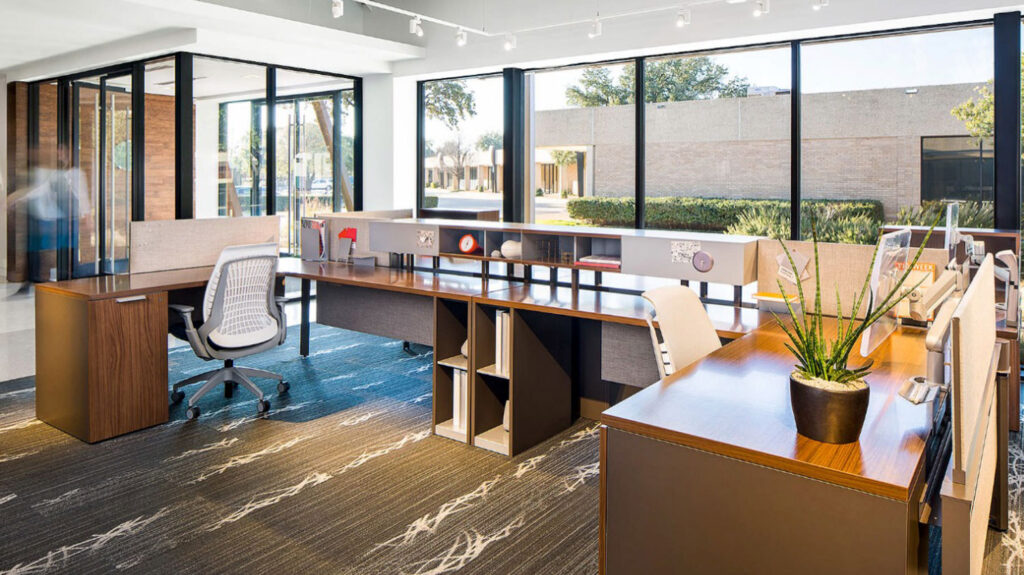In the dynamic landscape of modern offices, the physical environment plays a pivotal role in shaping the work experience and influencing employee productivity. A comprehensive research study conducted in 2022 revealed that strategically incorporating various design elements can enhance overall productivity by 12% & creativity by 21%. Let’s delve into the multifaceted aspects of workplace design that contribute to this transformative impact.
1. Breakout Spaces: Enhancing Focus and Collaboration
Breakout spaces are essential for fostering creativity and concentration, allowing employees to escape from their regular workstations. To maximize their effectiveness, the incorporation of soundproofing materials becomes crucial. For instance, Modular acoustic pods with high-density foam offer soundproof, focused work areas in open office layouts.
2. Collaborative Spaces: Enabling Seamless Information Sharing
Collaboration is the cornerstone of innovation, and designing spaces that facilitate effective teamwork is paramount. Integrating advanced video conferencing facilities in collaborative spaces enables real-time information sharing. This tech-enabled environment not only streamlines communication but also cultivates a culture of collaboration, boosting overall productivity.
For instance: Interactive smart boards with touch-sensitive technology in collaborative spaces enable real-time sharing and brainstorming, boosting teamwork and innovation.
3. Comfortable and Functional Furniture: Prioritizing Employee Well-being
Comfortable and functional furniture is not just an aesthetic choice; it directly impacts employee well-being and, consequently, productivity. Ergonomic chairs and desks are essential components, promoting physical health and reducing the risk of discomfort-related distractions. Additionally, agile furniture that adapts to various work settings encourages flexibility and movement, catering to diverse work styles.
For instance: Ergonomic task chairs featuring a breathable mesh back and adjustable lumbar support ensure comfort and good posture, enhancing well-being and focus during long work hours.
4. Adequate Storage: Decluttering Spaces for Mental Clarity
A clutter-free workspace is crucial for mental clarity and focus. Adequate storage solutions ensure that employees have organized spaces, reducing visual distractions and promoting a sense of orderliness. This design principle aligns with the popular adage: “A tidy space equals a tidy mind.”
For instance, Under-desk storage units crafted from sustainable, durable materials help declutter workspaces, allowing for the stowing of personal items to reduce distractions and enhance mental clarity.
5. Access to Technology: Empowering Seamless Workflows
The integration of technology is not just confined to collaborative spaces. Throughout the workplace, providing access to cutting-edge technology, from high-speed internet to integrated software solutions, ensures seamless workflows. Tech-enabled meeting and huddle spaces equipped with smart devices elevate communication and enhance overall efficiency.
For instance:Conference rooms featuring sound-absorbing wall panels and smart display systems enable seamless, tech-enabled communication, enabling efficient meetings with high-speed internet and integrated software.
6. Sustainable Design and Indoor Air Quality (IAQ): Prioritizing Employee Health
Sustainable design principles, including the use of daylight and eco-friendly materials, not only contribute to a greener environment but also positively impact employee health and well-being. For instance, a Green Wall or Vertical Garden
For instance: Green walls or vertical gardens with sustainable planters and air-purifying plants improve indoor air quality and promote employee well-being, contributing to a greener environment.
Also, In today’s changing business world, prebuilt offices are no longer leftovers; they’re ready-to-move-in showcases. Building owners and tenants find appeal in these spaces, which offer quick solutions post-pandemic.
In the end, as we figure out new and better ways to design offices, they become not just places to work but places that help people work better together and feel satisfied.

